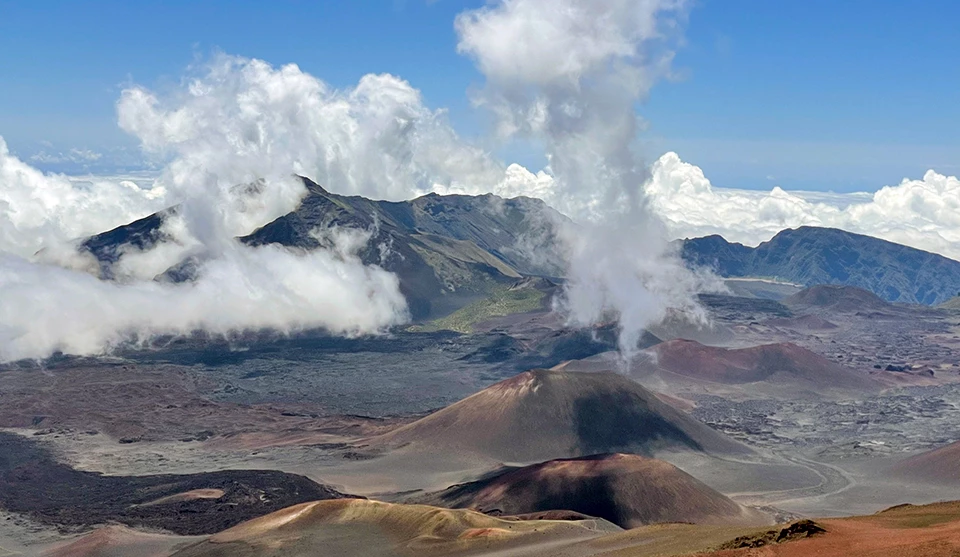Last updated: January 13, 2023
Article
Experiencing a Health Victory While Exploring Haleakalā

NPS/Sierra Needles
Accomplishments come in all shapes and sizes. Recently, one of my greatest achievements was looking at the vast Pacific Ocean and surrounding islands after making it to the summit of Haleakalā National Park on the island of Maui in Hawaii.
At 10,023 feet, I stood atop the volcano, looking out into the distance as clouds rolled in. For most people, it’s a spectacular view after a long car ride with many switchbacks. But not many can understand the sense of accomplishment I felt, as a 22-year-old with a debilitating chronic illness, to be able to ride in the car to the top of a volcano.
When I was planning my visit, I really wanted to make it to the summit, but I tried not getting my hopes up. Living with a chronic illness can have significant impacts and limitations on what I am able to do some days, and I feared not being able to explore Haleakalā would be one of those limitations.
When I first became ill, a lot was taken away from me. I was no longer able to do a lot of outdoor activities I enjoyed including hiking, which is now very challenging with my illness. This has forced me to adjust my expectations of my body and be okay knowing I may not hike while visiting national parks.
The chronic illness I live with is Postural Orthostatic Tachycardia Syndrome (POTS). I am sharing my victory at Haleakalā National Park in hopes that it can be an inspiration and resource for someone else who is planning a visit or for someone who previously thought visiting this park would be inaccessible.
My illness has not taken away from my experiences in the parks. The purpose and value of visiting a national park is not measured by the hikes one can complete. Rather it is the connection one feels to the preserved natural and cultural resources that determines one’s enjoyment of the parks.
Planning
While planning my trip to Maui, visiting Haleakalā National Park was at the top of my list, and it was one of the most recommended places to visit. I relied heavily on the Haleakalā National Park website to plan my day in the park. It was helpful to have information about fees, reservations, weather, things to do, and park accessibility all together in one place. There are pages about nature, education, history, and the park’s culture, along with videos, virtual tours, and live webcams that helped me learn about the park. I used the information I found to plan a fun, easy-going, accessible day trip to the park.
People recommended taking in the breathtaking sunrise or sunset from the top of Haleakalā. However, I knew that going at either of those times would be busy. My symptoms are sometimes worse in the morning and I thought waiting for sunset would be risky, fatigue-wise, after a day of sightseeing.
Instead of taking the chance of not feeling well at those times, I decided on a time when I usually felt good and when the roads and the summit area would be less crowded. I also designated a full day to the park. This allowed me to use my energy to enjoy the park and not feel like I needed to conserve energy for other activities.
The Volcano Conquering Day
On the morning of the volcano visit, I walked out to our silver rental car with my mom, dad, and sister. With arms full of camera gear, water, snacks, hats, and sweatshirts, we loaded the car, and I set up the route finder to direct us to Haleakalā National Park.
As I watched the map load, I felt giddy with excitement but also nauseous with the fear I may not be able to make it to the top. I did not want to be the reason we needed to turn around. With one last look in my bag, I made sure I had my chronic illness and road trip essentials: trail mix, my medications, water bottles, potato chips, spray bottle fan, popcorn, motion sickness medication, seasickness bands, peanut butter crackers, mints, apples and electrolyte mixes. What an interesting combination, right?
I struggle with elevation changes, so going from sea level to over 10,000 feet in several hours gave me gut-wrenching anxiety about how my body would fare. Not only was I worried about the elevation change, but I was also stressed about the windy roads to the top.
With each sharp switchback, I prayed my stomach would be okay. Part of my chronic illness is chronic nausea, which sometimes hits while sitting still, so zipping around corners and gaining significant elevation with each turn caused immense worry. (This is where the mints, motion sickness medication, and sea sickness bands put my mind more at ease.)
We paid the entrance fee and continued on to the first visitor center to use the restroom. I worried about the location of restrooms in the park because with chronic illnesses come chronic bathroom trips.
Before this adventure, I mapped out available bathrooms to ease my worries about having a flare-up of symptoms and needing a bathroom. There are two bathrooms along the way to the summit, located at two of the visitor centers. On the Haleakalā National Park website, there is a full page for information about the visitor centers, including directions, photos, amenities, and hours of operation. I was unsure how far apart they were, so before leaving the hotel, I checked the distance to the first visitor center. Then I looked up the distance from the first visitor center to the second one. Knowing these distances gave me peace and eased my mind.
Victory
If there is one part of that day that will forever be etched in my memory, it was the feeling I had the last few miles as our rental car inched closer to the summit. I tried not to get too excited. I worried I would jinx it, but it was too late. I was starting to bubble up inside with relief, gratitude, and excitement. I looked out the window with a huge smile as we drove around those last few curves to the summit parking lot. I took a deep breath as we pulled in … I made it.
I stood at the top of a volcano in Hawaii, something I did not know if I would ever do. I felt such a sense of accomplishment. I was able to conquer ascending a volcano with a debilitating chronic illness.
Unfortunately, I felt the effects of the over 10,000-foot altitude change. My head was throbbing with sharp pain all over. However, I came prepared. I drank my water, ate a snack, took some medicine, and sat in the car for several minutes, waiting for my body to better adjust to this new altitude. After a few minutes, it was time to explore the beautiful area of the summit.
Standing in the shallow air and looking out over the ocean, I grasped what this accomplishment meant for me. I walked around and then looked for a place to sit and admire the view.
Sitting on the sharp, loose, gravel-like rock, I sat in silence. At this moment, I felt deeply connected with nature, awestruck by how cool it is that there are places all over the United States that are protected so people can have moments like I was having…a feeling of peace that does not often come while living with a chronic illness.
Not only did I feel pure joy, but I felt hopeful about my future and my ability to travel and see beautiful places around the world.
This national park inspired and lit a fire in me to visit and learn more about other protected lands in the United States. Everyone deserves to feel the calmness and peace I experienced sitting atop the volcano. The National Park Service is committed to making parks accessible for people of all abilities so everyone has an equal opportunity to connect with and benefit from these conserved areas. I hope people utilize the access we have in-person and virtually in the United States to see and learn about these protected, natural, and life-changing parks.

About the Author
Sierra Needles is a travel and health writer studying journalism and media communication at Colorado State University. She is working in partnership with Colorado State University and the National Park Service to write about accessibility in national parks.
